Carrying photography gear – camera bags and alternatives
There are a number of different ways to carry around your camera and any extra lenses and accessories with you. In this article I examine the benefits and drawbacks of each approach.
Photography Backpack
Photography backpacks come in a wide range of sizes and models, so you should be able find one that suits you and the amount of photography gear you like to carry around with you. Many photographers own a number of different size bags, so they can use a smaller or larger bag depending on how much gear they want to take with them for a particular shoot.
Photography backpacks have padded sides and dividers to protect your equipment. The dividers in virtually all bags are user adjustable and attached to the bag by velcro so you can re-arrange the dividers to suit your gear.
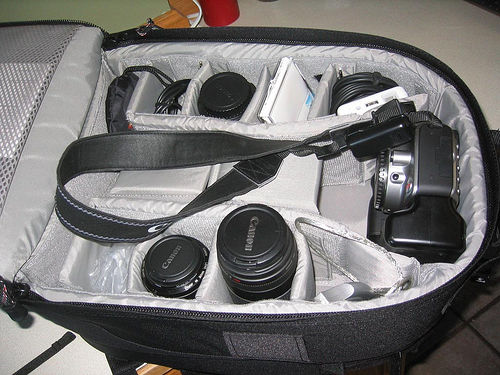
My camera bag. by miguelb on flickr (licensed CC-BY)
The bags also have wide padded shoulder straps, which helps ease the weight of a bag loaded with heavy lenses and equipment. Larger bags also have waist straps, which helps move some of the weight of the bag to your waist, relieving the strain on the shoulders somewhat.
Larger photography backpacks often come with a way to attach a tripod, either to the back, or side of the bag. This saves you having to carry the tripod separately, though obviously puts more of a weight strain on your back and shoulders.
The main advantage of photography backpacks is that they allow you to carry quite a large quantity of gear (depending on the size), and spread this weight out over both your shoulders (and often your waist as well).
The disadvantage though, is that whenever you want to get something out, you have to take the bag off your back. Depending on the bag size and weight, you may well have to put it down somewhere to open it. If you're somewhere muddy or dirty, this isn't ideal, and it's not the quickest way to be able to access your equipment either.
Neckstrap and pockets
The lightest way to carry your gear is to just carry your camera on its neckstrap round your neck / arm. Unless you have a camera with a heavy lens attached, it shouldn't put very much strain on your neck.
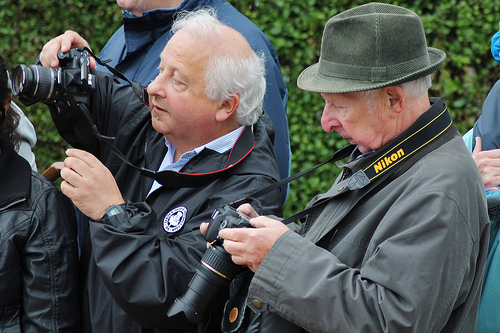
Photographers Photographed by Charles Clegg on flickr (licensed CC-BY-SA)
One of the methods to carry a camera this way is to have the neckstrap so that it goes round your neck and then under one arm. You can then swing the camera around under your arm when you're not using it. This avoids it bouncing around on your front while you're walking along.
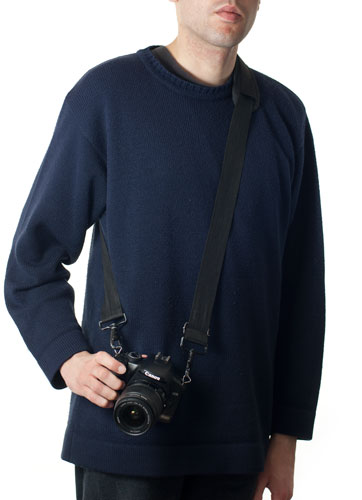
Camera on strap that goes round neck and under one arm
You can also carry one or two extra lenses or accessories in your pockets, depending on the lens / accessory size and your pockets size. However, remember that your pockets don't offer much protection against bumps and knocks, so you need to be careful when doing this.
The obvious disadvantage to this method is that you can't carry much. The main advantage is no extra weight or bags are needed, and of course, there's no cost. You can easily access lenses or accessories stored in your pockets as well, so lens changes or adding a filter can be done quickly and easily.
Sling bag
A Sling bag is very similar to a backpack. They have padded sides and removable dividers, and come in a variety of sizes. Unlike backpacks, they have one strap, which runs diagonally across the bag, usually from the left shoulder to the waist on the right hand side.
This design allows you to 'sling' the bag around to your front when you want to access the contents of the bag. This is much faster and convenient than accessing gear stored in a standard photography backpack.
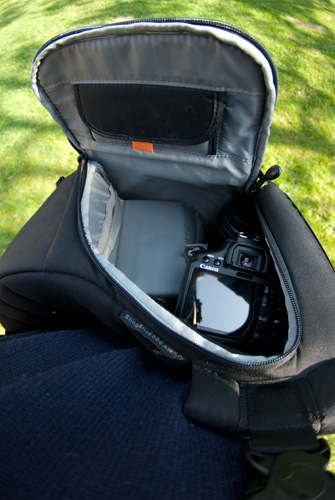
Sling bag slung round to the front with side open for easy access of camera and lenses
However, it is normally only gear stored at the side of the bag where the side opening flap is located that will be easily accessible. If you want to access gear stored further down in the bag, you will need to take the bag off and access it like a normal photography backpack.
The disadvantage of sling bags is that all the weight of the bag is on one shoulder. Some of the larger bags do have waist straps as well, but it still puts more weight on a single shoulder than a standard backpack does. With light weight loads this is not much of a problem, but photography equipment is quite heavy, and it doesn't take much until the single strap can become uncomfortable. This can particularly be a problem if walking long distances with the bag.
Shoulder bag
A shoulder bag can be carried over the shoulder, and offers quick access to items stored in the bag by opening at the top. As with photography backpacks and sling bags, they usually offer dividers that you can arrange as you want to your specific gear.
Like sling bags, the heaviness of a shoulder bag can start to wear on your shoulder depending on how heavy the gear stored in the bag is, and how long you carry it for.
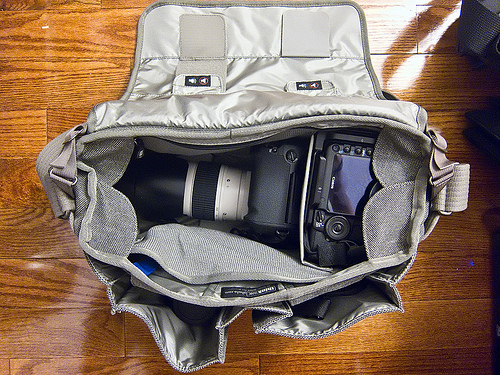
Possible Bag Configuration #1 by saebaryo on flickr (licensed CC-BY-ND)
Photo vest
Photo vests are basically a vest with lots of large pockets you can store your lenses and other accessories in. They don't have as much padding as a photography bag, but spread the weight of the gear out over your body. They also make it easy to change lenses or retrieve accessories, since you just have to take whatever you want out of your pocket.
The main disadvantage of photo vests is that you can look a bit out of place when wearing one. In hot weather they can be a pain since taking it off means you can't easily access the gear stored in it, and depending on how much gear you have stored in it, it could be heavy to carry as well.
Tripod carrying
If you like to carry a tripod with you, you have a number of options. Some backpacks allow you to attach the tripod to the backpack, and carry it on your back.
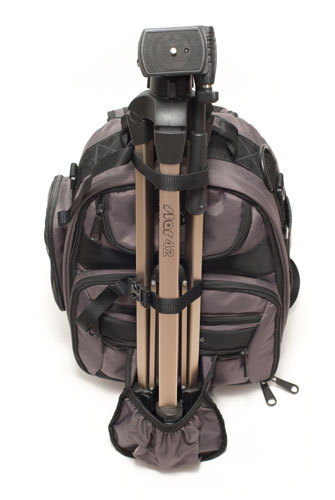
Bag with tripod attached
You can also buy tripod bags. Most have straps to allow you to carry the bag over your shoulder, and handles so you can carry it like a shopping bag if you prefer. These bags are usually padded to protect the tripod. Most tripod bags leave enough room at the top so you can keep the tripod in the bag with a head attached.
Another way to carry a tripod is by putting a strap under one (or two) of the tripod legs. Then wear the strap so it goes over one shoulder / the side of your neck, and under your arm on the opposite side, so the tripod hangs from the strap on one side of your body. This is probably the easiest way to carry a tripod, and means you don't have any bag or straps to undo when you want to access the tripod.
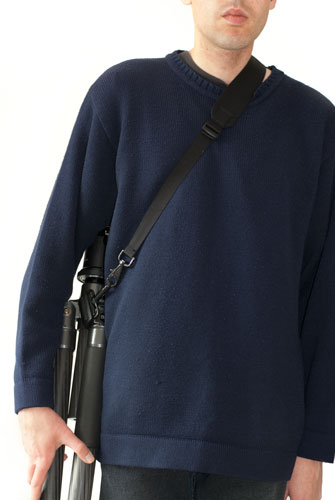
Carrying tripod by attaching strap to the tripod
A final way to carry your tripod is to just balance the tripod on one shoulder, holding onto the legs with your hand. This can cause some pain in your shoulder after a while, but shouldn't cause any problem over shorter distances.
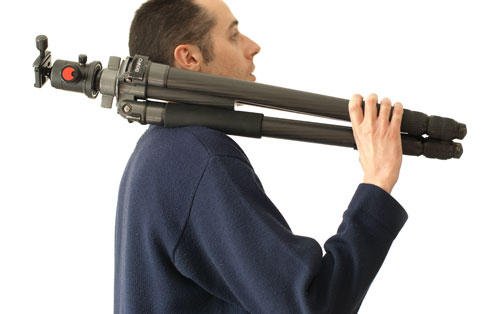
Carrying tripod on your shoulder
You don't need to fold up the tripod legs when carrying it like this (unless you are in a busy area). If you are taking some shots on your tripod, then want to move somewhere else nearby to get some more shots from a slightly different location, then this is an easy way to move the tripod.
In the end most photographers end up buying a variety of bags, and then using the different bags or no bag at all, depending on what they want to photograph, and how far they will bring the equipment. There are many different manufacturers of camera bags, and each manufacturer often offers a lot of different bags, so there is a very large choice.
If you are thinking of buying a new bag, search the internet to try and find reviews first. It might be worth checking eBay as well, to see if you can buy it cheaper second hand. If bidding on eBay be wary of getting over excited and bidding more than the bag costs new, like some bidders do.




